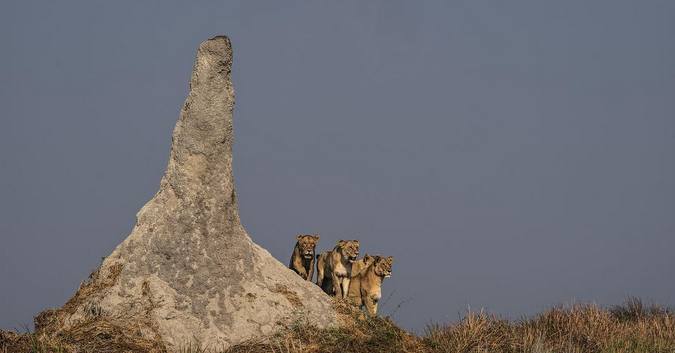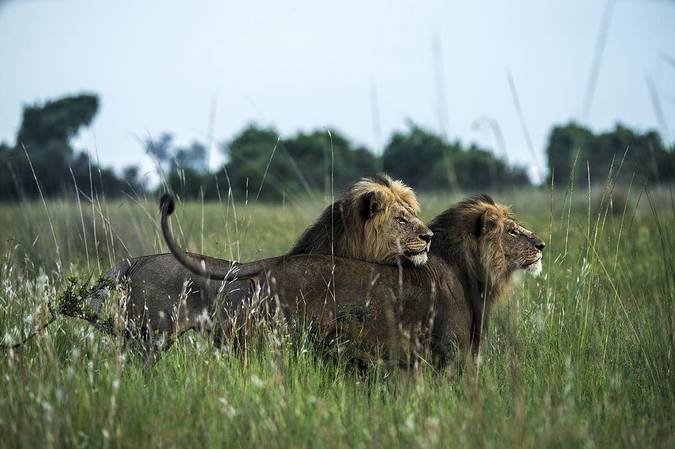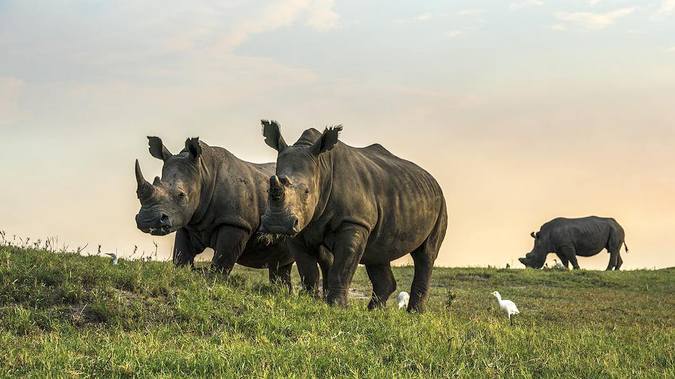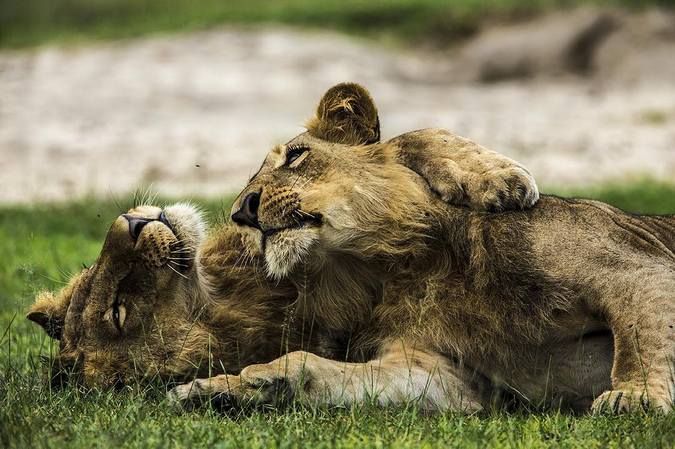
Opinion post by Dereck Joubert
I’ve been asked to respond to the following remarks that came up in a discussion following the broadcast of our latest Documentary, Birth of a Pride:
The remarks:
“He is exaggerating the extent to which hunting had anything to do with the near absence of lions and the extent to which his taking over the area contributed to the lions coming back again. The whole of northern Botswana has very unstable rainfall (like Namibia) – if it is dry (or flooded) in an area for a couple of years the herbivores move out and the predators go with them. When it rains (or the floods are lower) they all come back again – nothing at all to do with human interventions. They were certainly involved in moving SA rhinos to the Okavango, an intervention which allowed Great Plains and Wilderness to market themselves as big 5 destinations. They are not fake conservationists, but their approach to hunting and other forms of ultilisation is driven by a very narrow focus on the bottom line. Joubert is on record as saying that he would give a job to every hunting employee post ban, in reality he gave no jobs to anyone and his company did not take over any of the vacated hunting concessions.”
My response is detailed but is as follows:
Actually we lived in the area permanently through the hunting era unlike so many of the old ‘Hunters Africa’ hunters and friends of mine, who probably spent three or four months in the bush each year, and would probably not be considered ‘reliable witnesses’, in particular, they were doing the shooting. There will always be different opinions of how to USE the land and wildlife and the South African policy is pro-hunting, while the Kenyan, Uganda, and Botswana one is of no hunting. So the differences will always be there, and I have learned that trying to convince someone who has firm views one way or another is probably not going to be successful, but I can speak to some of the details you mention, just for accuracy for those who may be interested.
The demise of wildlife in what was once called Area 6 and now NG 16 is very clear. I wrote a paper on this for government in 1993 and lion researchers – Drs Winterbachs – similarly presented the results of zero recovery from excessive lion hunting in 2004 at the Lion Symposium. So the science is irrefutable. I personally saw hunters shoot the last 6 of 11 tsessebe, with sable antelope being shot for ration meat and fed to hunters’ dogs at home in Kasane. Elephants were wild and attacked Beverly and me nine times during that era as a result of being persecuted or wounded by hunters.
Once I may have been one voice in dozens at these symposiums, who felt that big cats were suffering from over-hunting. Today there are very few scientists that disagree. There are parallels to the Climate Change debate. People can simply deny it over and over – but it doesn’t go away.

With regard to the Selinda ecosystem, rainfall and trophy hunter behaviour
To suggest that an area in an open ecosystem like northern Botswana can collapse because of a drought is incorrect, especially along a permanent river system like the Linyanti! If anything it should be even more concentrated with wildlife as pools dry up in the interior and the Spillway, but with water remaining in the river. Droughts happen all the time and unless the wildlife is dying up against fences in closed systems, they simply follow the water and adapt most of the time. Some local resident species don’t move, but our study showed that even resident species like impala moved when they had to.
In fact, this dry cycle you talk of is exactly when most of the hunting took place, when the tectonic shift caused the drying up of the Savute channel, starting in 1981. As that happened, large numbers of wildlife flocked to the rivers – and were shot.
I have 15 years of detailed logs of hunters shooting madly from vehicles – at night, on baits – almost in a frenzy. And today, many of those same hunters tell me it was a crazy time of abundance and excess. Lions were shot down to such low numbers that male cubs started breeding with their mothers and sisters, and were then shot. New sub adult male cubs mated with their sisters, mothers and grandmothers just because hunters had shot out every breeding male in the region and beyond. Again, I documented this, as well as the rash of deformities the subsequent cubs were born with. Then it collapsed. So the notion that when it floods again, ’they all come back’ is a wonderful idea but not realistic if you are shooting them all, year in and year out.
By chance, when we took the concession over, the rains brought water into the Selinda Spillway again. We have annual game counts and official censuses on that recovery process. But there are still have species here that were very highly desired by hunters, and once occurred in good numbers but that have simply not recovered. In over 136,000 ha we have fewer than 400 zebras, and wildebeest are half that number. It took years for hyena numbers to recover, and they usually do really well in dry conditions. But as I recall, one hunter who had just slaughtered nine of them in one moment around a den (1997) answered me when I asked how he decided which to shoot, males or females (only males were legal even then): “Oh, hyenas are both male and female, they are hermaphrodites!”. This was 1997 I see in my notes – not 1897!! And this was by a licensed professional hunter.
There was no science behind what to kill, how many and when to stop. It was the Wild West, and these declines are just too easy to blame on a dry cycle. The recovery, as it is, is also not to be accredited to a wet cycle, but on sane wildlife management. At the time, by the way, wildlife advisors to Chief Tawana came to me to tell me what used to happen 100 years ago, and even then there was basic science on what not to shoot and kill, as hunters accounted for their kills, and if the chief noticed fewer of a certain species, or the stories were about how much harder it was to find something, he would place a ban on either that species or on all hunting. Those representatives asked me to help take their call for a ban to government.
I won’t go into the detail of what I saw and recorded in this post, but I can say that if there is a solid record of what happened in that area at all over a 30-year period of time, it lies in my notes, footage and photographs in my office, not in the rhetoric in the bars of Maun. That humans could behave like that was a disgrace, to be frank. Dragging a squealing and gutted duiker across the ground to a tree where it was wired up (still alive) to attract a leopard to shoot after dark (also illegal), diesel used to pour into warthog holes where a wounded leopard had run, and then set on fire; over 200 rounds of gunfire shot into a palm island where they thought a male lion was holed up, but ended up shooting his pride and eight cubs, and then later, setting the palm alight to “smoke the sucker out” – are all testaments to the atrocities. The male was wounded so couldn’t escape and burned to death, but the hunters logged it up to an accident and went on to shoot his brother. I saw all these things and heard the hunters tell the stories with no remorse afterwards around the campfires. Well known local professional hunters were nicknamed ‘Matches xyz’ and ‘Fireman xyz’ for burning the swamp to attract the rare sitatunga to kill, amongst other unsavoury hunts.

Buffalo herds, science tells us, are often indicator species and when you see them in their ideal numbers of around 250 in a herd, there is a balance. Larger herds in this habitat indicate high predator numbers (so their behavioural response is to band together as a defence). But very low herd sizes indicate massive human persecution (where the better defence is to disband and hide in the thickets). Selinda, between 1993 and 2010 had average herd sizes of 15-20. We have just taken over an ex-hunting area in Zimbabwe where the hunting was very heavy, and the herds are small there as well. In Duba Plains or places like Kidepo in Uganda those herd sizes are well over 1,000 – not because of habitat or drought, but because of high lion numbers. Anyone who denies that hunting, and in particular heavy or overhunting has no effect, is not being logical or totally truthful with themselves.
On the rhinos, we don’t actually market rhinos in Great Plains Conservation and with regards to this area, Selinda, we actually refused to move rhinos here, partly because it may be seen as us providing some commercial advantage to ourselves, which would probably be fine given that with our partners we raised the full $5m and brought them in, but I was always determined to “give” them as a gift to Botswana and the people of Botswana. If Wilderness Safaris do indeed market rhinos, it is not from the batch of nearly 100 we have donated to the nation of Botswana, but something they may have done themselves and nothing to do with me or marketed or condoned by me.
Besides that, frankly, I don’t think there are many people who would book a ticket to come to Africa to see rhino. Studies show rhinos to be quite low down the list of requested species (in Kruger), and below giraffe, for example. Booking a ticket to come and shoot a rhino – as is possible in South Africa or Namibia, is another thing, however, and studies also show that the more endangered a species the more desirable it becomes as a hunting ‘trophy’. If the price to shoot an endangered or threatened species is higher than the ‘yet to be threatened’ species, then my mind questions the conservation ethics of those hunters.

With regards to employment and other benefits
Selinda was a hunting area when I purchased it, so it came with its financial records, and I was able to analyse the different benefits to the two opposing management styles. It turns out that, where 12 semi-permanent staff were hired before, we now hire 140. (On the day we took over, 100% of our staff were, therefore, ex-hunting staff so in fact that alone refutes the statement that we didn’t hire any ex-hunting staff in itself.)
Those (all ex-hunting staff,) under the previous management, were hired for five months of the year and let go every year, so no 5, 10 or 15-year gratuities were ever paid to them. In addition very few advanced their careers. The most senior was a tracker earning about $1.60 a day. Today we have those same cooks and trackers as managers, as guides, as PR and HR staff in our offices, earning more than ten to twenty times that. And more relevant to me is that many have left us and moved into other sectors, in banks and businesses, and started their own companies. Airline tickets, curios, food supplies, fuel transport, etc. etc. all developed as a result of this conversion from hunting to photographic tourism.
In converting Selinda from a marginal area for hunting to one of the most productive wildlife areas in Africa, it has generated jobs and businesses around it for local communities. In fact, the net benefit (in a paper I did about six years ago), to the nation is 2,500% better than it is for trophy hunting! Jobs, taxes, skills, costs are all included, and we do that by inviting fewer than 50 people a day into the area, so the environmental footprint is minimal, and we do it without killing an animal. An analysis of benefit to communities is interesting because, by way of example, our guests have left behind around $1M in donations over the past few years, and a lot of that goes to providing communities with solar lanterns and a range of projects, We are about to start the Great Plains Academy to prepare some of the forgotten community members for higher education. This was not going on before.
By the way, around 15% of our current staff are ex-hunting employees and actually finding staff who were once hunting workers is getting even harder as time passes, as they are either absorbed into the tourism market or retire. We are constantly looking for staff to hire. Obviously, we have to train them and they need to be willing to be trained, but we are growing and will probably see the need for another 50 people to join us in the short term (18 months). We hire about 300 people in Botswana alone and over 660 across the group. According to the UN benefit proportion of breadwinners:dependants that means we put food in the mouths of over 4,000 each day. And we do it without shooting sable or elephants as ration meat. So the claim of us not hiring a single person is factually incorrect.
With regard to former hunting concessions
The allocation and management of retired hunting concessions has been a disappointment to all of us, and some areas have actually been gazetted as part of the National Park scheme, so they actually aren’t available for me or others to take over, even if we wanted to. But some of these concessions came up for tender two years ago, and we were the only company to apply to take over all eleven of these old hunting concessions. Unfortunately, that process was stopped for some internal government reason (possibly to do a survey on what could be incorporated into National Parks). We can hardly be blamed for not taking over an area that was not awarded at all, let alone to us.
Finally,
The debate on whether to hunt or not is not really relevant anymore as we stare down the barrel of 8 billion people on Earth and over 1 billion head of livestock in East Africa alone – and massive disenfranchisement across Africa, and within our communities. This is a real threat to wildlife. The answer, in my humble opinion, is in education, creating real benefits (like the Selinda model does), and in being respectful to those people who need us to drive the increase in their basic wealth and to fight poverty and corruption. The Okavango and the few wild places like it in the world deserve complete protection. The people who look after it deserve our respect. Dumping a rotting elephant carcass at their villages from time to time is not respectful or of real benefit to the poor. It may feed people today, but it doesn’t lift them up to that place where they can feed themselves. Together we need to tackle the far bigger problems with knowledge and passion and the deeper insight that local communities bring from generations of living side by side with nature, something we in the Western mindset are losing daily.
Kind regards,
Dereck

To comment on this story: Login (or sign up) to our app here - it's a troll-free safe place 🙂.![]()






